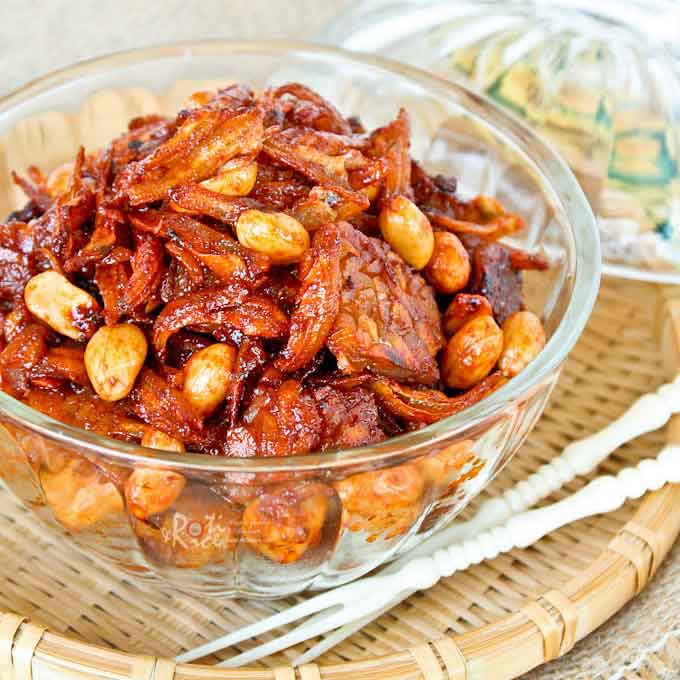Introduction
At Love With Recipes, we believe that exploring traditional Indonesian snacks opens a window into a vibrant culinary heritage rich with bold flavors and unique textures. The Kering Tempe, Teri, and Peanuts is a quintessential example of this, showcasing a delightful combination of crispy fried tempeh, savory anchovies (terik), crunchy peanuts, and a fragrant, spicy-sour seasoning blend. This dish is versatile enough to serve as a snack, side dish, or even a light appetizer, offering both satisfying crunch and layered flavors that tantalize the palate. Its popularity stems from the balance of umami, heat, sweetness, and saltiness, making it a beloved staple in Indonesian households and street food stalls alike. Whether you’re a seasoned home cook or a curious culinary explorer, mastering this dish will add a fantastic element to your repertoire of Southeast Asian cuisine.
Time
Total preparation and cooking time: approximately 45 minutes to 1 hour.
- Preparation time: 20 minutes
- Cooking time: 25 minutes
- Additional resting or marinating time: optional, if you choose to marinate ingredients for flavor enhancement
Needed Equipment
- Deep-frying pan or wok: For frying tempe, peanuts, and anchovies evenly.
- Slotted spoon or spider strainer: To lift fried ingredients from hot oil, ensuring minimal oil absorption.
- Mixing bowls: For preparing spice blends and mixing ingredients.
- Chopping board and sharp knife: For finely chopping shallots, garlic, and chili.
- Mortar and pestle or food processor: Optional, for crushing or blending spices to achieve the desired texture.
- Measuring spoons and cups: To ensure precise seasoning and ingredient proportions.
- Paper towels or clean kitchen towels: For draining fried items and maintaining crispiness.
- Stainless steel or ceramic bowl: To toss and combine ingredients after frying.
Tags
Indonesian Cuisine, Traditional Snack, Fried Tempeh, Spicy, Savory, Crunchy, Street Food, Southeast Asian Food, Vegetarian Option, Gluten-Free (if soy-based ingredients are omitted), Appetizer, Side Dish
Serving Size
This recipe yields approximately 4 to 6 servings, depending on portion size and whether it is served as a snack or side dish. Each serving provides a crisp, flavorful experience that pairs well with rice or enjoyed on its own.
Difficulty Level
Intermediate. While the individual steps involve frying and chopping, the process demands attention to detail to ensure ingredients are cooked evenly and flavors are balanced. Perfect for home cooks with some prior frying experience and a good understanding of flavor balancing.
Allergen Information
| Allergen | Source |
|---|---|
| Gluten | Potential, depending on soy sauce or shrimp paste used (shrimp paste contains shellfish) |
| Shellfish | Anchovies (terik) |
| Soy | Possible, if soy-based ingredients like soy sauce or miso are used in seasoning |
| Tree Nuts / Peanuts | Peanuts |
| Sulphites | Possible if preserved or processed ingredients are used |
| Allergens note: | This dish contains seafood (anchovies) and nuts (peanuts). Adjust accordingly if allergies are a concern. |
Dietary Preference
Vegetarian — can be adapted by omitting anchovies or replacing them with plant-based umami sources. The dish is naturally gluten-free if soy-based products are excluded or substituted with gluten-free options.
Course
Appetizer or Side Dish
Cuisine
Indonesian
Ingredients
Primary Ingredients
| Ingredient | Details |
|---|---|
| Tempe | 1 piece (20×20 cm), sliced thinly, fried until crispy |
| Peanuts | As needed, fried |
| Fried Anchovies (Teri) | As needed, fried |
Spice Blend
| Ingredient | Details |
|---|---|
| Shallots | 10, finely chopped |
| Garlic | 5 cloves, finely chopped |
| Bird’s Eye Chili | To taste, finely chopped or sliced |
| Kaffir Lime Leaves | A few leaves, thinly sliced or shredded |
Completing Spices
| Ingredient | Details |
|---|---|
| Palm Sugar | To taste, grated or dissolved |
| Salt | To taste |
| Shrimp Paste | A small amount, for umami depth |
Instructions
Preparation of Fried Tempe
Begin by selecting fresh, firm tempe. Using a sharp knife, cut the tempe into thin slices approximately 1/4 inch thick. This ensures the tempe cooks evenly and achieves the desired crispiness. For best results, slice the tempe just before frying to prevent moisture loss. Fill a deep-frying pan or wok with enough oil—preferably vegetable or peanut oil—to fully submerge the tempe slices. Heat the oil over medium-high heat until it reaches approximately 350°F (175°C). To test readiness, drop a small piece of tempe into the oil; if it sizzles and rises to the surface quickly, the oil is ready.
Carefully add the tempe slices to the hot oil, ensuring not to overcrowd the pan. Fry in batches if necessary. Fry until golden brown and crispy, usually about 3 to 4 minutes per batch. Use a slotted spoon or spider strainer to lift the fried tempe and drain excess oil on paper towels. Allow to cool slightly, then set aside for later use.
Frying Peanuts and Anchovies
While the tempe is frying, prepare the peanuts and anchovies. For peanuts, use raw or roasted peanuts, based on preference. Deep fry peanuts in hot oil until golden and crunchy, approximately 2-3 minutes. Remove with a slotted spoon and drain on paper towels. Similarly, fry anchovies until crispy, which typically takes about 2 minutes. Be cautious as anchovies can splatter during frying. Drain well and set aside.
Preparing the Spice Blend
In a separate skillet or wok, heat about 1-2 tablespoons of oil over medium heat. Add the finely chopped shallots and garlic, sautéing until fragrant and golden brown, approximately 2-3 minutes. Incorporate the sliced kaffir lime leaves and bird’s eye chili, stirring for another minute to release their aroma. Add palm sugar, stirring until it dissolves, balancing the flavors with salt, and a small amount of shrimp paste. Continue to cook until the mixture becomes fragrant and slightly caramelized, about 2-3 minutes. This process develops the complex umami and aromatic profile essential to authentic Indonesian flavor.
Combining Ingredients
Once the spice mixture is ready, turn off the heat. Gently fold in the crispy fried tempe, peanuts, and anchovies, tossing carefully to evenly coat all ingredients with the fragrant spice blend. Use a spatula or wooden spoon to mix thoroughly, ensuring each piece is coated with the seasoning. Taste and adjust seasoning if necessary, adding more chili for heat or salt/palm sugar for balance.
Serving
Transfer the mixture to a serving dish or bowl. This dish can be enjoyed warm or at room temperature. It pairs wonderfully with steamed rice, served as a side dish, or as a standalone snack for gatherings and festivities. For an extra layer of flavor, garnish with fresh herbs such as cilantro or lime wedges.
Preparation Tips
- Ensure tempe is sliced uniformly for even frying and crispiness.
- Maintain oil temperature consistently for optimal frying—use a thermometer if possible.
- Adjust the amount of bird’s eye chili based on your heat preference; start with a small amount and increase gradually.
- Use fresh kaffir lime leaves for a more robust aroma; dried leaves can be substituted but may have a milder scent.
- To intensify flavor, you can marinate the tempe slices briefly in a mixture of turmeric and salt before frying.
Nutritional Information
| Nutrient | Per Serving (approximate) |
|---|---|
| Calories | Approximately 250-300 kcal |
| Protein | 10-15 grams |
| Carbohydrates | 15-20 grams |
| Fats | 15-20 grams |
| Fiber | 3-5 grams |
| Sodium | 500-700 mg |
Tips and Tricks
- For added crunch, double fry the tempe slices—fry once until soft, then remove, let cool, and fry again until crispy.
- Use a mix of roasted and raw peanuts for varied texture and flavor.
- Incorporate a squeeze of lime or lemon juice before serving to add brightness.
- If you prefer less oil absorption, drain fried ingredients thoroughly and serve shortly after frying.
- Experiment with different chili types, such as Thai bird’s eye or serrano, to customize heat levels.
Add-ons
- Fresh herbs like cilantro or Thai basil for garnish
- Sliced shallots or fried shallots for extra aroma
- A drizzle of sweet soy sauce or kecap manis for a richer flavor
- Additional chopped bird’s eye chili for extra heat
Side Dishes
- Steamed jasmine rice or coconut rice
- Fresh vegetable salad with lime dressing
- Indonesian sambal or chili paste for added spiciness
- Tempura vegetables for a contrasting texture
Improvements
- Enhance umami by adding a splash of fish sauce or soy sauce to the spice blend
- Incorporate toasted sesame seeds or crushed dried shrimp for additional flavor depth
- Experiment with different nuts such as cashews for a different crunch
- Use homemade or high-quality shrimp paste for richer aroma and flavor
Save and Store
Because of the fried nature of this dish, it’s best enjoyed fresh for maximum crispiness. However, leftovers can be stored in an airtight container at room temperature for up to 4 hours, or refrigerated for up to 1 day. To restore crispiness, reheat in a hot oven (around 350°F or 175°C) for 5-7 minutes, avoiding microwave reheating which can make ingredients soggy.
FAQ
Can I make this dish vegan?
Yes, by omitting shrimp paste or replacing it with fermented bean paste or mushroom seasoning, you can create a vegan version that still retains deep umami flavor.
Is this dish spicy?
The level of spiciness depends on the amount and type of chili used. Adjust the quantity to suit your heat tolerance, starting with a small amount and adding more gradually.
What is the best way to keep it crispy for longer?
Serve immediately after frying, or reheat in a preheated oven. Avoid storing in the refrigerator for extended periods, as moisture will make the ingredients soggy.
Conclusion
This Kering Tempe, Teri, and Peanuts recipe from Love With Recipes offers a vibrant taste of Indonesian street food, combining the satisfying crunch of fried tempeh and peanuts with a fragrant, spicy seasoning. Its versatility makes it suitable for various occasions, from casual snacking to festive gatherings. By mastering the frying techniques and seasoning balance outlined above, you can bring authentic Indonesian flavors to your kitchen with confidence and flair. The complex layers of aroma, texture, and taste will surely impress your family and guests alike, making this dish a memorable addition to your culinary repertoire.
References
- Indonesian Food & Cookery by Sri Owen
- The Food of Indonesia by Janet De Neefe
Remember, for more delicious recipes and culinary insights, visit Love With Recipes, your go-to platform for passionate home cooks and flavor explorers!


